


 |
 |
 |
|---|
Desert Dawg - Electrical
System
Part
I
|
The electrical system on the Desert Dawg is going to
be as simple as possible. Of course safety is of primary concern so all
circuits will be fused and of appropriate wire gage. I plan on installing a 12v
DC system but no 110v AC system. I have little need for 110v doing the type of
camping that I typically do. On those occasions when I stay at a campground
with electrical hookups, I can simply use an extension cord with an outlet
strip. The only appliances that I will use with 110v will be a blow dryer and a
curling iron so I will be using them at the campground shower anyway. I've divided the wiring up into three basic systems; one for the trailer running lights, one for the battery charging circuit, and one for the cabin. The trailer wiring is going to be pretty simple. It makes sense to follow the industry standard wiring color scheme. I will be using a 6 prong plug so I can charge the trailer battery from my towing vehicle. The remainder of the trailer wiring will be similar to any small utility trailer. 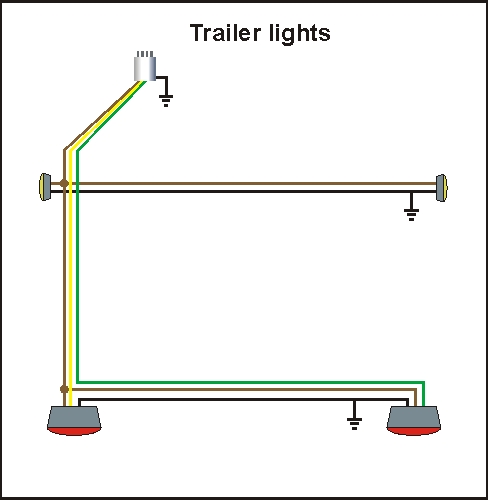 The tow vehicle will charge the trailer battery as I drive. I have read some discussions about battery isolators versus a switch controlled solenoid. In hopes of eliminating a failure point I am going to utilize a solenoid rather than the isolator.  As expected, the cabin wiring is the most complex system on the trailer. It seems like the people I know who own RVs are always having problems with their electrical systems. I want this system to be as reliable as possible while retaining the ability to maintain the system when the need arises. Although I don't expect to be dragging the Desert Dawg through the wilds of Baja, I would like it to be constructed in such a manner that I wouldn't hesitate to do so. Each of the cabin circuits will have have a ground wire that returns to a common grounding block. This should eliminate the problems associated with poor or intermittent grounding.  April 3, 2005 Here is the beginning of the trailer wiring. This wiring is for the running lights, clearance lights, and turn signals. I found some plastic conduit at the local trailer supply so I decided to run the wires inside of that. I'm hoping that using the plastic conduit will keep the wires up and out of harm's way. As trailers get older it seems like one of the first things that happen is that wires start to hang down underneath. I don't want that to happen on this trailer.  This picture shows the left side wires put up in place. I bought circle clips to hold the plastic conduit and riveted them in place along the frame rail. I don't think that this wiring will be giving me any problems in the near future.  The cabin wiring will be installed as the shell is constructed and the interior gets finished. June 29, 2005 I want to finish the under-trailer wiring before I permanently attach the deck to the trailer frame. The battery is going to be mounted inside of the tongue box and the fuse panel is going to be located in the galley area so I'm going to need to run the main 12v wires down the length of the frame. I've decided to put them inside of flexible conduit in order to ensure that they are protected from road hazards or sharp corners that might wear through the insulation and cause a short. I'm going to have to start thinking about the fuse panel before long. I've found one at West Marine that would work well but I don't particularly like the way it looks. After looking at a couple of the panels that they offered, I may make my own. Here is a picture of the main wiring mock-up. I purchased some wire clamps that I will rivet to the frame to secure the conduit. 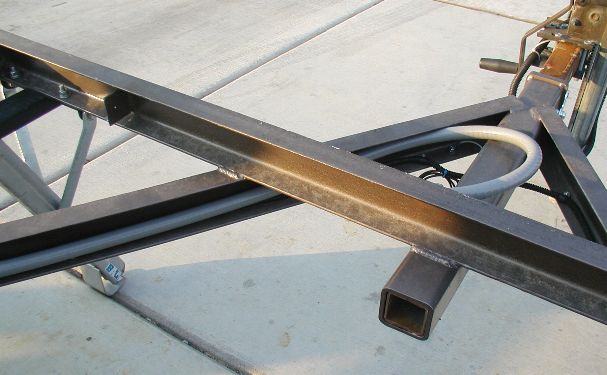 July 3, 2005 I've decided to finalize the installation of the 12v conduit while I am waiting for some of the epoxy to dry. Although this is easy work, it does take a little while to get it all installed. In the end I think it turned out pretty well. Although my trailer isn't nearly as fancy or pretty as many of the teardrops I've seen, I'm hoping that by doing things right the first time that the trailer will be trouble-free in the years ahead. 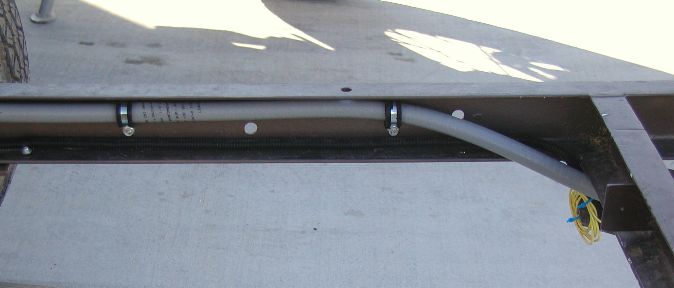 July 23, 2005 Today I had a shopping trip to the local trailer supply store. It was a pretty expensive trip but one that has been long over due. Most of what I bought was electrical; interior lights, reading lights, wire, 12v outlets and stuff like that.  One of my purchases was 15 feet of red and black 8 gage wire for the run from the battery on the tongue to the fuse panel in the galley. The weather wasn't cooperating in letting me do any real work on the trailer so I decided to run the wire through the flexible conduit. Couldn't be easier, right? That's what I thought too. Instead it turned in an hour of pulling, pushing, pulling and finally having to remove the electrical conduit from the trailer to get the wire though. Even with a "fish" to pull the wire though, it was a real challenge. Perseverance prevailed! July 29, 2005 I could purchase a read-made fuse panel, but I've decided to make my own. I know! I know! What was I thinking?!? A trip to Radio Shack secured me most of the electrical parts that I need. I made a quick stop at Office Max to pick up a plastic clipboard that I would use for the panel face. The local auto parts store provided the 14g wire I will use to wire up the panel. I wanted a digital 12v meter but the price on them is steep. My thought is that I can buy an inexpensive multi-meter and mount it to the back of the panel.  The first step was to see how everything would fit on the panel. It is almost like playing Scrabble using electrical parts rather than letters. After trying a number of different layouts, I found one I think will work.  The bus strips will be the distribution point for all of the electrical circuits. One strip is for power and the other for ground. The LEDs will indicate that the circuit is hot and that the fuse hasn't been blown. Being the computer nerd that I am, I did all the layout for the panel in CorelDraw. That gave me the option of trying different spacing of the components and locations for holes. After several revisions I settled on this design. I printed the panel layout and taped it to the plastic face. Once in place I was able to mark the locations for all the holes. I've cut an opening for the meter to show through and give me the voltage reading for the battery. The voltage difference between a full battery and a dead battery isn't very great so having a digital meter is almost a "must". 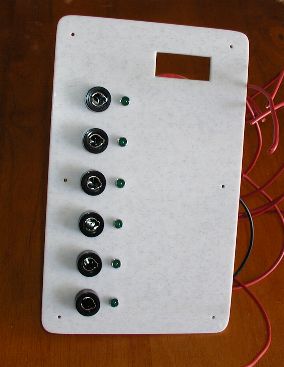  I still have quite a bit of work to do before I complete the fuse panel, but I've made a good start on it. August 20, 2005 This is the weekend I have been working on the exterior sheeting. Before I got too far along I decided to drill holes through the wall and roof framing to allow installing of the wire. I think I have gotten all of them that I need to drill. I don't want to miss any because it's only going to become more difficult as more of the trailer is completed. I will be doing the rough wiring in the next few weekends. Pictures to come! August 28, 2005 I have reached the point where I need to start running the rough wiring. I purchased a 100 foot spool of 14 gage wire. The wire has two leads within a sheath so it should make it easier to get all the wires hooked up. 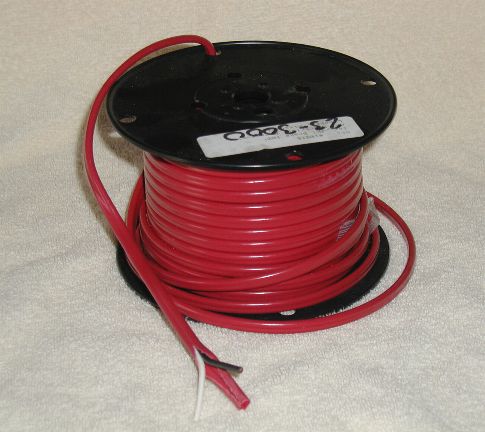 Here is a photo after I finished the cabin wiring for lights and fans. There will be a couple of additional circuits for the radio and 12v outlets. I'll run those circuits when I build the bulkhead and cabin storage cabinets. 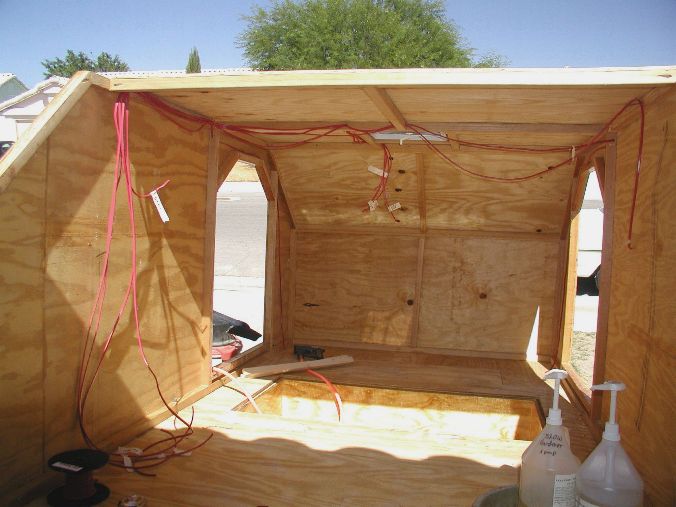 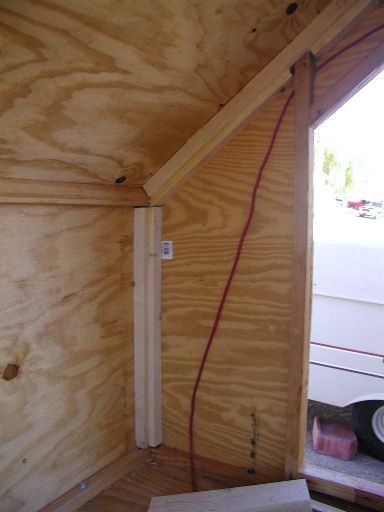 Slow but steady progress! October 15, 2005 It seems like the electrical system gets a little work here and a little there, but no big effort like building the frame or the cabin. That doesn't mean it isn't important though. All the wires are going to be sealed inside the walls so it has to be done right the first time. Trying to fix the wiring after the trailer is completed would create quite a challenge. My trailer only has a 12v system since I rarely camp where electricity is available. There is a lot of current available, but not a lot of voltage. Those trailers that have 110v have to be even more careful that they design and install their system correctly. Done wrong, electricity can spoil your whole day. Fires and electrocution come to mind and they don't sound like fun. 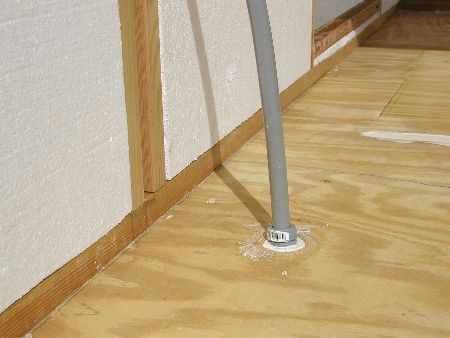 The trailer has good ventilation through the roof vent and the door windows. I can even prop open the front window although it doesn't have a screen to keep bugs out. A lot of builders are using a roof vent with a built-in fan. The price is a lot higher than I want to pay so I'm going to take a different approach. I'm not convinced that I need to move the volume of air that the vent fan provides so I'm going to use one computer fan on each side of the trailer. Each fan moves about 25 cubic feet per minute so the two fans will turn the air over about every three and a half minutes. I think this will be adequate to keep the air from becoming stagnant. Their low current draw will allow me to run the fans without fear of draining my battery. 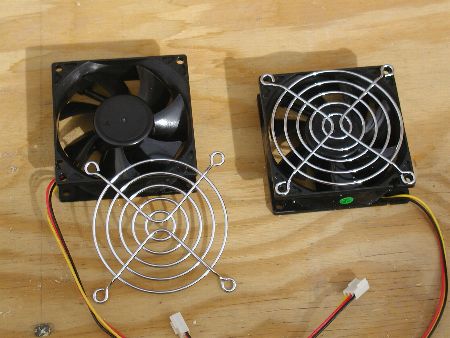 November 21, 2005 I was fortunate enough to receive a donation to the Desert Dawg. I wasn't ready to go out and buy a battery yet but it's nice to have one ready and waiting. My friend's dad has a 5th wheel and this was an extra battery. Now I can buy the battery box and get it mounted at the front of the trailer.  January 28 - 29, 2006 As the interior of the cabin starts to get put into place, I will be making progress on the electrical system. Now that I've installed the side walls I need to get the ventilation fans put together and installed. I had cut a square out of each side wall so I can mount the fan. I used a compass to mark the circle I wanted to cut out. I used a small sanding drum in a Dremel to finish the hole after roughing it out with a knife. I will use screws with decorative washers to mount them back into the walls  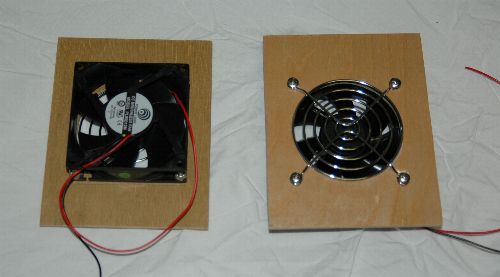 February 05, 2006 Installing the fan is a simple effort. I just soldered the fan wires to the wires that I had already put in place before installing the interior panels. Then I used upholstery screws to attach the fan units to the studs on each side. 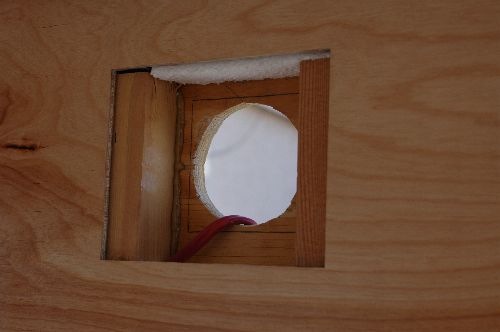 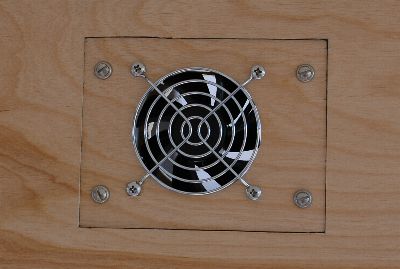  I'm installing the fans and light fixtures as I get to them. I don't want to have a lot of electrical work to do all at once.  February 18-20, 2006 I intended for today to be focused on finishing the cabin interior, especially the ceiling. Then it occurred to me that before I buttoned up the ceiling I had better be certain that all of the cabin electrical was working correctly. I didn't what to have to start tearing into the paneling up to fix, replace, or add on to the electrical system. 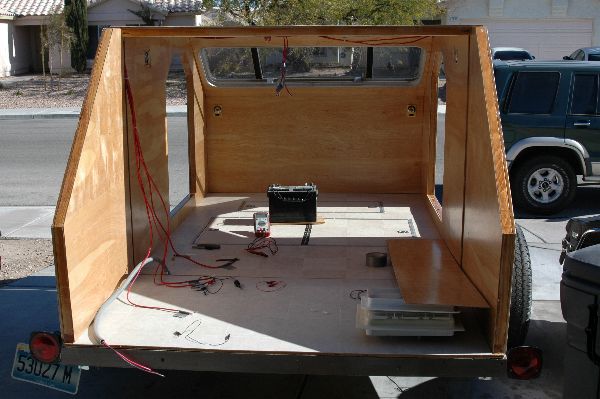 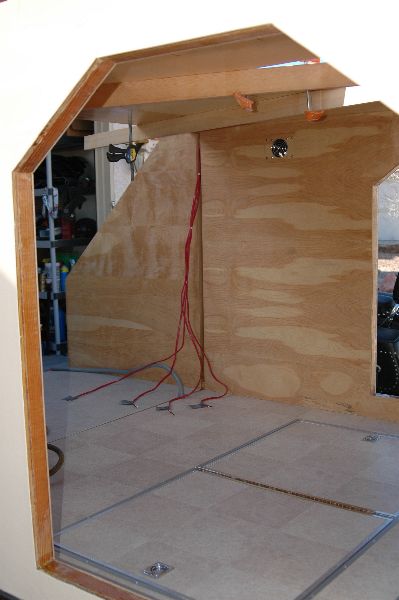 Initially I was going to use crimp-on wire connectors to hook together the wires of each circuit. I started to run into problems when I realized that the fan circuit would need me to join four wires together in a single connection. There just isn't a good way to connect that many wires together using crimp-on connectors. That lead me to decide to install a bus strip in the ceiling to hook everything together. That led me to the next quandary, "How do I install a bus strip in the ceiling and still get access to it so I can hook everything up?" Then the light went on, so to speak. I could cut an access hole in the ceiling and cover it with the overhead light. Simply remove the light if I have any future changes to make. Problem solved! 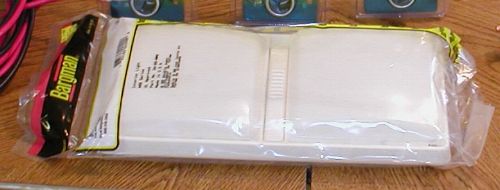 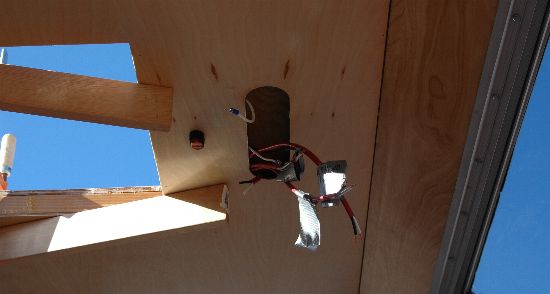 The bus strips were screwed right into the plywood roof so I had to be REAL careful not to use screws that were too long! 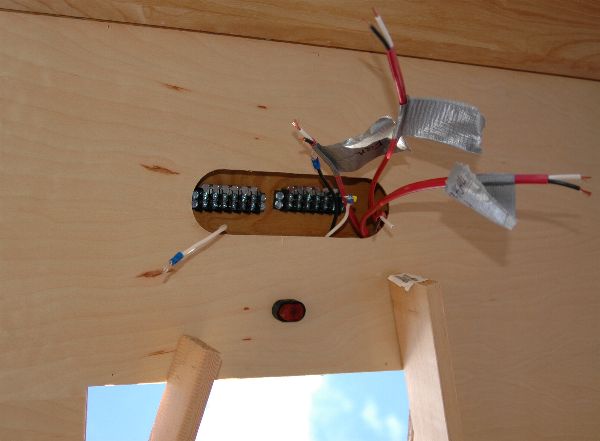  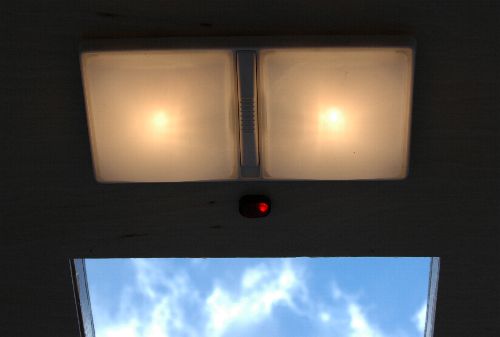 It's time to start working on the galley so I have some electrical work to do here as well. The fuse panel is going to be mounted on the bulkhead between the cabin and the galley so I have to rough in the wiring before I go much further. 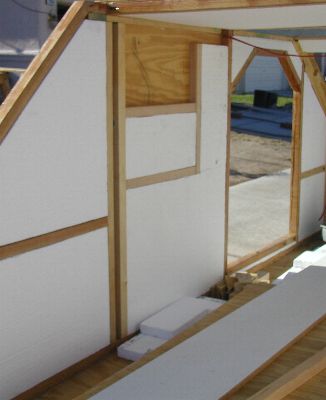 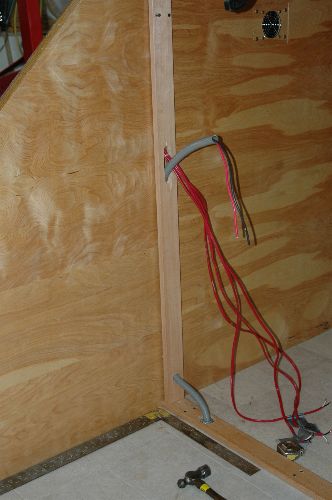 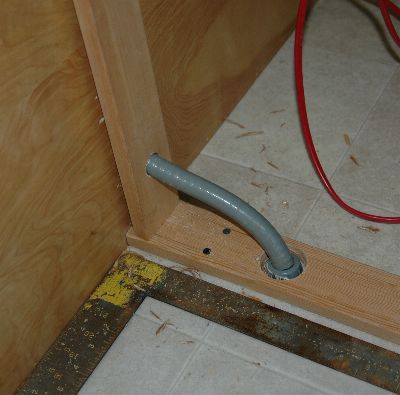 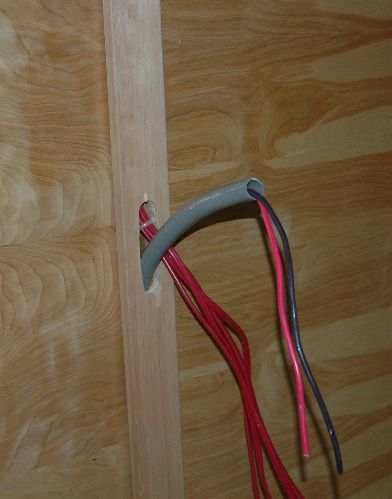 February 25-26, 2006 I need to run the remainder of the cabin electrical before I can button up the bulkhead. I am going to have a couple of 12v power outlets in the cabin for TV, Radio, or whatever else runs on 12v. They even make 12V electric blankets. Now we're talking! 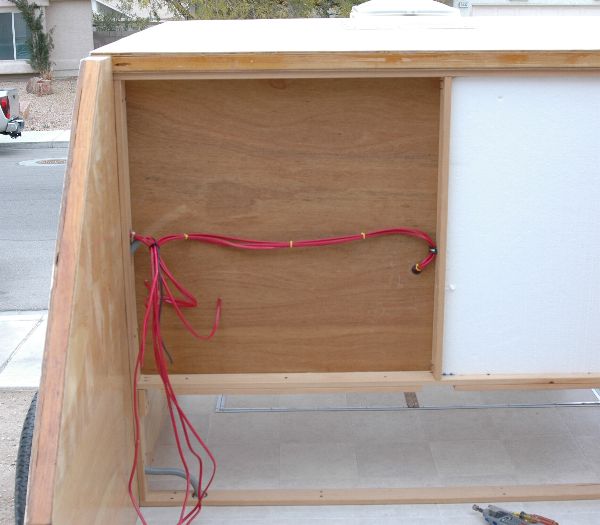  March 4-5, 2006 I've routed the wiring out of a hole in the bulkhead. The main 12v feed as well as all of the individual circuits terminate here. It's about time to finish the electrical panel. It won't be long before I have to wrap up the wiring. 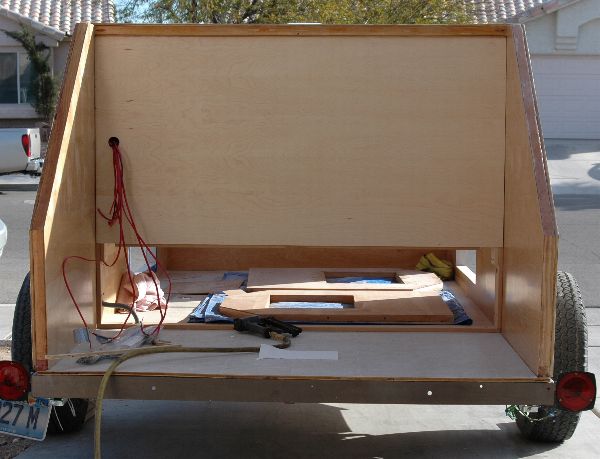 March 25-26, 2006 The battery box have been underfoot long enough, so I've decided to go ahead and mount it. I can't just drill straight down through the center tube since the hitch is removable. Originally I was going to use some sort of U-bolt arrangement but I just didn't like the way it was going to work. Finally I decided to weld a couple of pieces of angle iron on the center tube. Now I have something I can drill holes through!  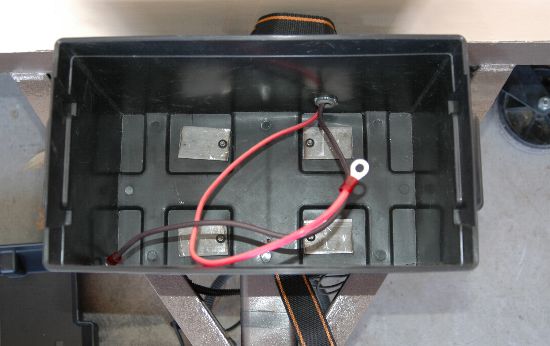 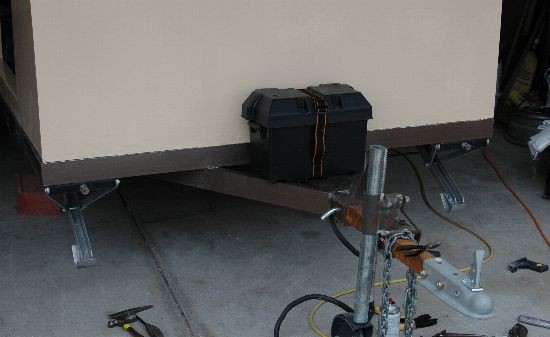 April 7 - 8, 2006 I would really like to complete the majority of the wiring this weekend. Getting the fuse panel installed is one of the remaining tasks I have to face. I am going to see how far I can get before the weekend is over. I'm going to build a small box to conceal the wiring. The fuse panel will be attached to the front face of the box. 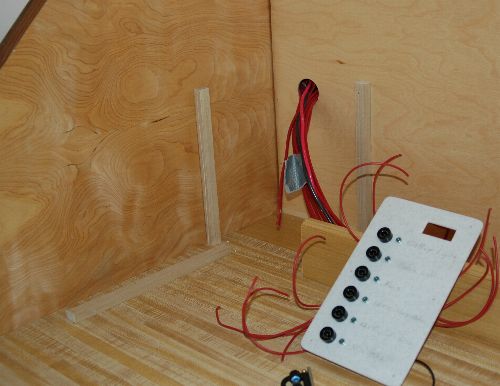 If you couldn't tell by looking at the cabin wiring, I'm a fan of the barrier strips. They greatly simplify getting all the wiring connected together. I could solder the appropriate circuits together but a barrier strip will make it much more flexible. In the future I can change or add additional the wiring as I find it necessary. 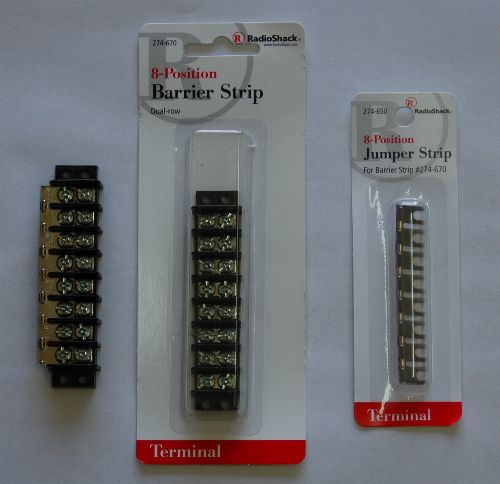 Ok, Ok. I've gotten a bit carried away. Give me a few moments to explain what I'm doing and maybe it will all make sense. Of course, maybe not. In the picture below, the bus strip on the far right is going to be the common ground for all of the circuits. The primary feed from the battery negative terminal is attached to this strip. The bus strip on the far left will be fed from the positive terminal of the battery. From that bus, wires will lead to the fuse panel then on to the center bus strip. Soooo, the left bus is the unfused, positive bus. In the center is the fused bus. On the right is the ground bus.  Here you can see where the positive lead from the battery connects to the unfused bus. (at left) On the right I'm getting ready to connect the ground bus to the main ground lead from the battery. 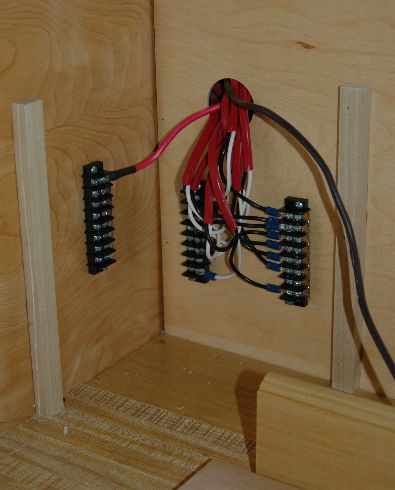 I'm starting to build the box around the wiring. The fuse panel will be attached to the front of the box.  April 17, 2006 My plan to use the Radio Shack volt meter has been scrapped. After shelling out the money to buy the meter and carving it up so it would fit behind the fuse panel, I found out that it automatically turns itself off after a few minutes. This sounded like a great feature until I realized that the only way to turn it back on was to turn the front dial. The front dial is going to be behind the fuse panel so there is no way to get to it. Sheesh. My first thought was to do without a battery meter, but I'm just not convinced that is a good idea. I really like the idea of being able to know the status of my battery. I spent some time on the internet and found a digital volt meter that I can put directly into the panel. It's not a modified volt/ohm meter like the one I tried, but rather a volt meter made specifically to be installed into panels similar to like mine. PayPal is my friend and the meter is on its way to my house. I've temporarily installing the fuse panel. After I receive the volt meter I'll take the fuse panel back apart and install the meter.  That should complete most of the interior wiring. I will need to hook up the radio and outlets in the cabin, but that happens after I build the interior cabinets. |